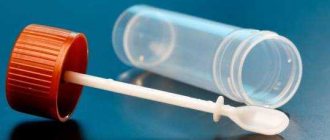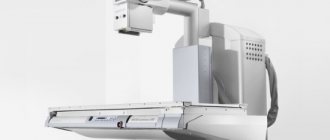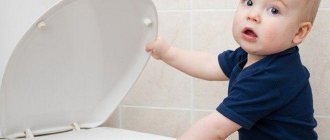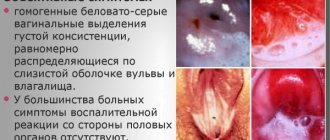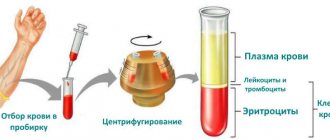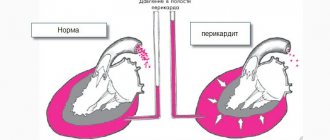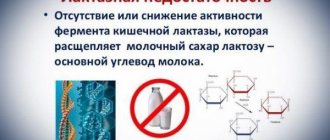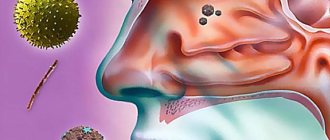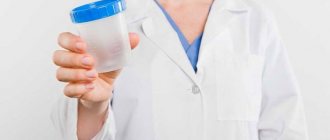Preparation and collection of analysis
Stool examinations are used not only to diagnose diseases, but also to assess the effectiveness of therapy.
Therefore, preparations begin a few days in advance. It is necessary to stop taking medications that affect digestion. These are the following types of drugs:
- aluminum-based antacids;
- pancreatic enzymes;
- antibiotics;
- antifungal;
- bismuth preparations;
- metformin and its analgias;
- medications that block fat absorption.
Probiotics and prebiotics, suppositories with a laxative effect can change the result of the study. A special diet for 3-5 days is also recommended. Heavy foods, fried, spicy, smoked, and all irritating foods are excluded from the diet. The basis of nutrition should be dairy products, cereals, grain bread, fruits, eggs, lean meat and some vegetables.
You cannot collect stool using an enema. You need to empty your bowels on your own.
Before collecting stool, X-ray contrast studies of the digestive tract should not be performed. If the procedure was necessary, wait at least 2 days to cleanse the body.
Avoid urine and toilet water from being included in the analysis. For the study, 5-10 g of feces is enough; the sample is placed in a plastic container with a sealed lid. It is stored in the refrigerator until sent to the laboratory. If you need to test stool for dysbacteriosis, then, on the contrary, it cannot be cooled.
What does a stool test show?
The results of the analysis are deciphered by the doctor based on the conclusion of the laboratory assistant. The description specifies various stool parameters. Normally, its color is dark due to the pigment stercobilin, but in case of pathology of the liver and biliary tract, when the excretion of bilirubin is impaired, the stool becomes lighter. Impurities of scarlet blood are an indicator of bleeding in the lower intestines.
The laboratory technician assesses the pH of the stool. If it is shifted to the acidic side, this indicates fermentation processes that are normal for the body and appear with a carbohydrate diet. Rotting shifts the pH towards the alkaline side, this may be a consequence of a predominantly meat diet.
The composition of stool is examined and the following is determined:
- muscle fibers and connective tissue that normally appear in young children but should not appear in adults;
- neutral fats and fatty acids – can be in minimal quantities;
- fiber is usually present in the form of coarse fibers that are not digested;
- starch is not normally detected; it appears in case of digestive disorders and in children under one year of age.
The coprogram also indicates the presence of iodophilic flora, which indicates the predominance of decay processes and dysbiosis. Single blood cells are not a pathology, but a large number of red and white blood cells should be alarming.
A coprogram is an important study, the results of which can be used to judge the functioning of the intestines and other organs of the digestive system. If indicated, it should be submitted in time to detect pathology.
A coprogram is a type of laboratory examination of feces, based on the determination of physical, chemical and microscopic characteristics, which allows one to diagnose abnormalities in the functioning of the organs of the digestive system in general and each individually.
This analysis allows you to characterize the state of the child’s gastrointestinal tract, and, if necessary, assess the degree of progression of the disease and the effectiveness of its treatment. The particular value of the study is due to the fact that the bolus of food, from which feces are subsequently formed, passes through the entire intestine and ultimately provides maximum information about the state of all its departments. There is no difference whether scatology or coprogram is prescribed, so from the point of view of the essence of the study it is one and the same.
Coprogram: how to get tested
No one thinks about the need to correctly pass the coprogram, and the health workers themselves often forget to warn about some of the features. But these little things often lead to false positive results. Therefore, you need to remember important points. It is better to collect feces the day before delivery. Doctors recommend conducting the study no later than 8-10 hours after defecation.
- It is undesirable for the stool to contain impurities of urine or menstrual blood, so it is important to perform a toilet of the genitourinary organs before donation.
- If the analysis is collected to determine the fat and nitrogenous products contained in it, the analysis is taken immediately for weighing.
- Use only glass or plastic containers.
- For bacteriological examination, feces are collected in sterile tubes or special penicillin bottles.
What the analysis shows
The coprogram allows you to identify various pathological processes and determine the intensity of their development. Indications for performing stool coprogram in children are suspicion of:
- acute or chronic dysfunction of the stomach;
- pathology of the pancreas;
- liver diseases;
- impaired absorption in the duodenum;
- diseases of the small and large intestines, including the rectum;
- disturbances in the functioning of the gallbladder and bile ducts;
- infectious intestinal lesions;
- celiac disease;
- worms;
- oncological diseases.
Differences from other analyzes
The main advantage of the coprogram is the ability to diagnose a number of diseases, while other stool tests are narrowly targeted:
- stool analysis for worm eggs - identifying the presence of helminthiases;
- stool analysis for carbohydrates - detection of lactase deficiency in children under one year of age;
- stool analysis for dysbacteriosis - identifying disturbances in the normal intestinal microflora;
- occult blood test - allows you to detect the presence of minor traces of blood as a result of a violation of the integrity of the mucous membrane in the gastrointestinal tract.
Also, the differences between the coprogram and other analyzes are:
- obtaining maximum information about the general condition of the digestive system;
- the ability to determine disturbances in the functioning of each organ involved in the digestion process;
- combination of several types of research at once;
- the ability to simultaneously identify internal problems and determine parasite infestation.
Indications for the study
A scatological examination is prescribed in several cases: for symptomatic patient complaints (blood in the stool, constant pain and cramps in the abdomen, intense gas formation, constipation (constipation), diarrhea, etc.), as part of a general diagnosis of diseases of the gastrointestinal tract (gastro- intestinal tract) and hepatobiliary system, as well as oncological diseases.
In addition, the doctor prescribes tests for suspected pathologies:
- inflammatory lesions of the digestive system;
- venous swelling in the rectum and anus (hemorrhoids);
- Crohn's disease;
- cirrhosis of the liver;
- oncology and bleeding of the gastrointestinal tract;
- colon polyps.
The study is not carried out for preventive purposes. How much coprogram is done depends on the medical institution where the biomaterial was accepted for analysis. In Moscow and other large cities, the deadline is one day. A general stool test for coprogram is prescribed when it is suspected:
- parasitic infestation (worms) and amoebic dysentery;
- infection and poisoning.
The value of the study in these cases lies in its efficiency, that is, the ability to quickly detect and identify the pathogen. Young children are prescribed to have feces submitted for scatological microscopy in case of allergic reactions, colic, as well as other problems with stool and digestion, in order to diagnose helminthiasis in a timely manner.
Preparing for analysis
No complicated preparation is required before taking the test; sweet, spicy and fatty foods should be excluded from the diet 2-3 days before taking the material. But this recommendation most likely applies to older patients, since baby food does not involve the use of this type of product. When the feces of a breastfed child are submitted for examination, the diet must be followed by the mother. When preparing for the test, the following are prohibited:
- enemas;
- taking laxatives;
- use of medications that change the color of stool;
- taking enzymes;
- taking antibiotic drugs.
Features of material collection
- Only feces obtained through natural bowel movements are suitable for analysis.
- Contact of feces with urine is not allowed.
- Feces are collected from infants from a previously laid oilcloth, and from a pre-washed potty from older children.
- It is necessary to take spot samples of stool from the entire mass.
- The total volume of material should be approximately equal to 1 teaspoon (how much feces is needed for a coprogram does not depend on the number of detected parameters).
- The material must be placed in a special container purchased at the pharmacy.
Important! If the child was taken to another country by his parents in the month preceding the analysis, it is necessary to inform the medical professional about this. This somewhat changes the assessment of the study results.
To prevent feces from mixing with urine, you can use a special device - a urine collector. It is bought at the pharmacy taking into account the gender of the child. When using it, urine will remain in a special bag and will not get into the feces.
Permissible standards for detritus content
There is no clear quantitative indicator; in the results of the coprogram, one or more pluses are usually given opposite the “detritus” column.
Norm of detritus in feces
- large quantity – (++++++);
- minimum content of detritus in feces – (+);
- very small amount – (+/-).
When deciphering the coprogram, the doctor takes into account the presence of pathological indicators in the stool, the patient’s complaints, data from instrumental diagnostic studies and the general condition of the patient. Therefore, only a specialist can correctly explain the analysis answer.
Delivery of material
The material for research is sent to the laboratory immediately after collection, since feces begin to change rapidly over time. When it is not possible to immediately transfer the material to specialists, it can be stored in the refrigerator at a temperature from +2 to +5 o for no more than 8 hours. It is important that the container with the material is closed very tightly.
If a disease of the gastrointestinal tract is suspected, the doctor, as a rule, immediately prescribes a coprogram to the patient - a study of physical, biochemical and microscopic indicators of feces. Any deviations from the norm allow us to identify serious disorders of the digestive tract. This study requires special preparation, which will ensure high accuracy of the result.
How to properly collect biomaterial?
The algorithm for collecting stool in children is determined by age. For a child who goes to the toilet to use the potty, it will not be difficult to collect biomaterial. The main rule is that the pot must be clean. It must be thoroughly washed with baby soap and then doused with boiling water. Any chemicals for cleaning the pot are an absolute taboo. Secondly, the child must be washed after each bowel movement. Parents cannot always predict when they will be able to collect biomaterial, so the baby should always be prepared for this.
The collection of feces is carried out with a special stick. The approximate amount of required biomaterial is 10-15 grams. The excrement is placed in a sterile jar and tightly closed, after which the analysis should be sent to the laboratory within a few hours. The maximum delivery time is 8-9 hours, provided that the stool is stored at all times at a temperature not exceeding 5 degrees. Biomaterial for the presence of helminths must be brought to the laboratory within 30-60 minutes.
Particular attention should be paid to the issue of stool collection from infants. If the baby is breastfed, before the analysis the mother must go on a strict diet that excludes the following foods:
- fried, fatty and pickled foods;
- citrus;
- chocolate and its derivatives.
In this case, excrement is collected from the diaper. If your baby has loose stools, it is best to place a disposable absorbent diaper under his bottom. In infants with constipation, the use of a gas outlet tube is allowed (for more details, see the article: rules for using a gas outlet tube in newborns). A coprogram in an infant is most often performed to confirm dysbacteriosis.
Rules for taking the analysis
Passing a scatological analysis requires careful preparation; the main activities are aimed at maintaining diet. Following a few simple rules will ensure high accuracy of the result, allow you to correctly determine indicators and identify problems in the gastrointestinal tract.
A patient who is going to have a coprogram a few days before the test must follow one of two diets:
- Pevzner diet. According to it, children are allowed to consume no more than 3,000 kilocalories per day. The diet should be limited to black and white bread, fried or boiled meat, rice/buckwheat, potatoes, butter and fresh apples.
- Schmidt's diet. The permissible norm of kilocalories per day is 2400. Allowed foods are dairy products, butter, eggs, meat products, potatoes and oatmeal.
If your baby needs to take a stool test for occult blood, it is recommended to stop eating green vegetables and fruits, tomatoes, meat, fish and eggs (we recommend reading: table for deciphering blood tests in children by age). Before coprogram, you should also avoid medications that contain iron.
Preparation for stool analysis includes the following exceptions:
- laxative medications, including rectal suppositories;
- drugs that can change the color of stool (for example, barium sulfate);
- antibiotics and enzymes;
- performing enemas;
- drinking coffee drinks.
How to prepare and pass?
Special preparation for stool analysis is not required, since material obtained naturally is taken for the study.
In order not to distort the results of the study, you must follow simple rules on how to prepare for a coprogram.
A week before the test, refuse:
- Antibiotics;
- Iron-containing drugs;
- Any laxatives;
- Use of rectal suppositories;
- Enema;
- Procedures through the anus;
- X-ray with barium.
Preparation for coprogram includes dietary restrictions 4 - 5 days before stool delivery. The diet before coprogram consists of the following menu:
- Dairy products;
- Mashed potatoes;
- Lean meat;
- Porridge;
- Soft-boiled eggs;
- Fresh fruits;
- White bread with butter.
Preparing for a study if hidden bleeding is suspected requires complete abstinence from meat, green vegetables, tomatoes, and most fruits, otherwise the analysis may give a false result.
Preparing the patient directly for donating material involves purchasing a container for testing and organizing hygienic conditions for defecation. It is forbidden to collect feces from the toilet - only from a clean surface. You need to take care of a potty or disposable pad in advance.
How to take the test correctly:
- Perform natural defecation, avoiding urine and genital discharge;
- Using a special spatula, scoop out the amount of material needed for analysis - about a third of the jar;
- For the best result of the study, it is advisable to follow the recommendations on how to collect feces for coprogram - at least from three different areas of feces;
- Screw and label the container.
How to properly take a stool test so that the biomaterial does not deteriorate : take the biomaterial to the laboratory on the same day, no later than 12 hours after defecation. If necessary, place the container on the refrigerator shelf.
A coprogram of feces from an infant is collected whenever possible, since it is difficult to control the frequency and time of bowel movements of the child. For analysis, a teaspoon of biomaterial placed in a sterile container is sufficient. If a child does not go to the potty, the problem of how to collect feces from a baby can be solved with the help of disposable diapers - feces can be collected from their surface.
Decoding indicators
Deviations in physical, biochemical and microscopic parameters in the coprogram may indicate a certain disruption of the digestive tract:
- Changes in the consistency of stool. In infants, loose, loose stools are considered the norm (for more details, see the article: what to do if a breastfed baby has foamy stools?). Dense stool in the form of lumps may indicate constipation; the same symptom is also typical for children over one year old. Loose stool in a baby over 1 year old indicates diarrhea, and foamy stool means the presence of an intestinal infection in the body.
- Presence of impurities in feces. According to the transcript, in infants up to three months of age, the presence of mucus in the stool can be considered normal. In babies over one year of age, concern should arise from the remains of undigested food, indicating problems with the pancreas, as well as blood, which is a sign of possible bleeding in one of the intestinal sections.
- Violation of the acid-base environment. Doctors can decipher this indicator as follows. Excess of pH occurs when protein rots, resulting from excessive consumption of meat. If the pH is below normal, then there is reason to talk about impaired absorption of fatty acids and intolerance to dairy products.
- Presence of bilirubin. Bilirubin can only be detected in the analysis of an infant who is on breastfeeding. In all other cases the reaction should be negative. If bilirubin is present in the stool of an older child, this indicates diarrhea, gastroenteritis or dysbiosis (see also: what should be done if blood is found in the stool of an infant?).
Why is it dangerous?
The presence of tripel phosphate crystals is a signal of an inflammatory process in the digestive tract, in particular, protein decay in the colon .
Protein intake from food is vital, as new cells are formed from them. Therefore, you need to include proteins of different origins (plant and animal) in your diet. In order for proteins to perform their role, they must be broken down into amino acids. This process begins in the stomach under the influence of hydrochloric acid, then continues in the duodenum and small intestine. After this, amino acids are absorbed into the blood through the intestinal walls.
But due to disturbances in the gastrointestinal tract, some amino acids enter the large intestine. The microorganisms located there break them down to form toxic substances. Thus, the protein rots. The breakdown products of this process enter the venous bloodstream and then into the liver.
Over time, this gland is unable to neutralize the toxic products of protein decay. Then some of these poisons are carried through the blood throughout the body, causing: nausea, colic, a feeling of heaviness, rumbling in the stomach, bad breath, headache.
Also, the process of decay intensifies due to dysbiosis, when the ratio between beneficial and harmful bacteria is disrupted in favor of the latter. This can cause diarrhea, cramping abdominal pain, general intoxication, allergies, and deterioration of the skin and nails.
When proteins rot, ammonia , which is absorbed into the blood. As a result, there is a negative effect on the central nervous system. Oxygen starvation sets in. In this case, weakness, depression, and depression are observed.
The presence of tripelphosphate crystals also indicates increased motility in the intestinal tract.
Normally, part of the bilirubin entering the colon should be converted into stercobilinogen, which should subsequently be oxidized to stercobilin. This is what turns the stool brown. With profuse diarrhea, the movement of intestinal contents accelerates and bilirubin does not have time to be converted into stercobilin. The human body becomes dehydrated and loses many essential microelements.
What does a change in the color and smell of stool indicate?
Since breastfed babies produce bilirubin for up to six months, stool may turn green. When taking iron supplements, the excrement is black. The stool of the older child is predominantly brown. Deviations from the norm indicate the development of pathology:
- black color is a sign of bleeding in the stomach or duodenum;
- yellow color is a symptom of fermentation in one of the intestinal sections, sometimes due to excessive consumption of dairy products;
- discolored, white - manifestations of viral hepatitis, dysfunction of the duodenum or cholelithiasis.
The smell of excrement may also indicate dysfunction of the digestive tract:
- too fetid odor helps to identify rotting processes in one of the intestinal sections, as well as microflora disorders;
- a sour odor, unless aged up to one year, indicates excessive fat content;
- too weak odor is observed with constipation.
How to decipher the results?
A specialist must evaluate the results of the coprogram, taking into account all the conditions: the patient’s complaints, the characteristics of his diet, the existing medical history, and indicators of other studies.
Let's look at how to decipher deviations from the norm:
- Too little feces occurs with constipation, colitis, and ulcerative conditions. An increase in feces indicates accelerated evacuation and inflammation in the gastrointestinal tract.
- Very dense feces are formed due to excessive absorption of fluid through the intestinal walls, constipation. Liquefied stool is caused by active peristalsis and admixtures of inflammatory mucus. Ointment-like consistency is a possible consequence of chronic pancreatitis. Foaminess indicates fermentation in the intestines.
- A large form of feces indicates a long stay of the contents in the intestines, which may be associated with dysfunction of the colon due to poor nutrition, a sedentary lifestyle, diverticulosis, or tumors. Small lumps (sheep feces) occur with intestinal spasms, hemorrhoids, anal fissures, fasting, and peptic ulcers. Excrement in the form of a ribbon or a thin column indicates rectal stenosis or the presence of a neoplasm. Unformed stool is a sign of impaired digestion and absorption of food due to enzymatic deficiency.
- Color changes not associated with food staining are likely symptoms of disease. Discoloration of stool is caused by liver failure and blockage of the bile ducts. Tar-colored feces are a sign of bleeding in the upper gastrointestinal tract; if there is bleeding in the colon and rectum, the feces are red. Typhoid fever produces mushy green stools. Yellow excrement is produced by fermentation in the intestines.
- The mucus in the coprogram has a different consistency and shade depending on the pathology. Gray inclusions resembling rice water indicate cholera infection. Amoebic dysentery is manifested by a jelly-like mucous mass of pink shades. When the rectum is affected, mucus impurities are found in the material in whole lumps and ribbons. In case of colitis and constipation, mucus envelops the formed stool on top; in case of inflammation of the small intestine, it mixes with food masses and gives them a semi-liquid character.
- In some cases, blood does not stain feces, but is released along with them in the form of separate clots and veins. We are talking about bleeding in the lower digestive sections, ranging from anal fissures to necrosis of a colon tumor. Occult blood in the stool is determined by the Gregersen test.
- Purulent discharge in the stool is a sign of severe inflammation, ulcers, abscess, tuberculosis or a disintegrating tumor. In case of infectious lesions, suppuration is supplemented by mucus and blood.
- Pieces of undigested food in a stool test are called lientorrhea. Occurs when the functioning of the stomach and pancreas is disrupted.
- Small elements of digested food mixed with the remains of bacteria and epithelial cells (detritus) are the normal contents of feces. Only a violation of their homogeneity with the isolation of individual particles, for example, an increased content of bacteria during coprogram, allows one to suspect an inflammatory process. Detritus in a coprogram in combination with mucous and bloody impurities is an unambiguous sign of pathology. Detritus in a coprogram in an infant or a child older than one year without accompanying symptoms is not a cause for concern.
- Iodophilic flora in the coprogram causes fermentation in the intestines. These bacteria are identified by staining with iodine and the acid reaction of feces (pH 5.0-6.5). Pathological iodophilic flora (clostridia) leads to active fermentative dyspepsia.
- If yeast is found in the stool, candidiasis caused by taking antibiotics is possible.
- Muscle fibers in the coprogram can be detected both in digested and unchanged form, which is not the norm. The presence of muscle tissue in the stool is called creatorrhea and indicates poor digestion of proteins: impaired secretion of gastric juice, insufficiency of pancreatic enzymes. The same applies to the remains of connective tissue in the stool.
- Problems with lipid digestion result in steatorrhea. Neutral fat in the coprogram is released during pancreatic dysfunction and blockage of the pancreatic ducts. Disturbances in the duodenum lead to poor absorption of fatty acids. Soaps in coprogram are salts of fatty acids in feces as a result of bile deficiency.
- Starch in coprogram (amilorrhea) is a consequence of enzymatic deficiency and too active peristalsis. The release of intracellular carbohydrates indicates that the source of the pathology is the stomach: starch is not digested due to the fact that gastric juice does not process plant cells. Extracellular starch in the coprogram appears due to amylase deficiency.
- Leukocytes are not normally detected in the coprogram. Their presence indicates an infectious intestinal lesion, enteritis, colitis, or ulcerative lesions. The combination of leukocytes with erythrocytosis, a large amount of squamous and cylindrical epithelium in the stool shows a coprogram for intestinal cancer, polyposis, Crohn's disease. If leukocytes are detected in the coprogram of an infant, the results need to be analyzed in combination. In the absence of other alarming symptoms, a positive test occurs in healthy children with an improperly organized diet.
Cost of the procedure
Stool analysis is now carried out in all public and private diagnostic centers. The cost depends on the city in which the research is carried out, as well as on the completion time. As a rule, the result of the coprogram can be obtained in 5-6 working days. In medical centers, if necessary, they do urgent tests, which cost a little more. The average cost of research in the capital is approximately 400-600 rubles. In Kazan, the test can be done for 300-400 rubles, and in Samara for 200-250.
Research methods
Microscopic analysis of stool
Analysis of stool - a coprogram is carried out by microscopy, the fragment is ground between glass slides and its composition is assessed. If the feces are too thick, add a small amount of water or sodium chloride solution and grind it with a glass rod until a smooth consistency is obtained.
To identify iodophilic microflora, crystals of fatty acids, drops of neutral lipids, staining reagents are used that change the color of the pathological component.
In microscopic analysis of feces, detritus constitutes the main background and is a mass of granular components. The more complete digestion of food occurs, the more detritus there will be and the fewer differentiated elements there will be.
When decoding the results of the coprogram, organoleptic and physico-chemical indicators are indicated. Based on the data obtained, the doctor evaluates the properties of feces, identifies pathological inclusions indicating the development of any disease of the intestinal tract, changes in acidity, microflora and the total volume of digested food fragments.
https://youtu.be/zriUjcDLmM8
